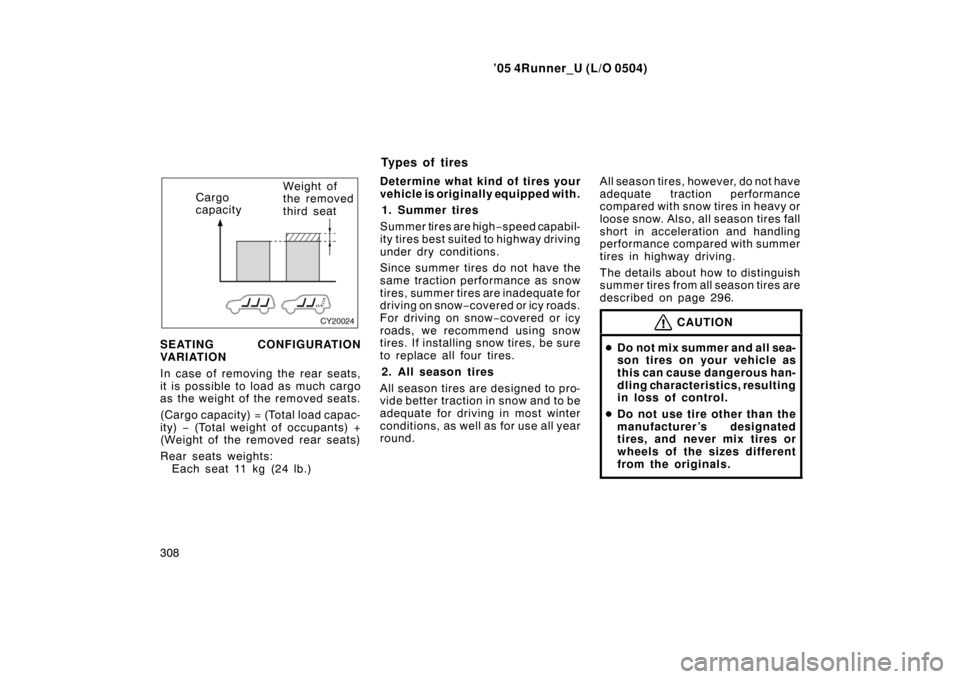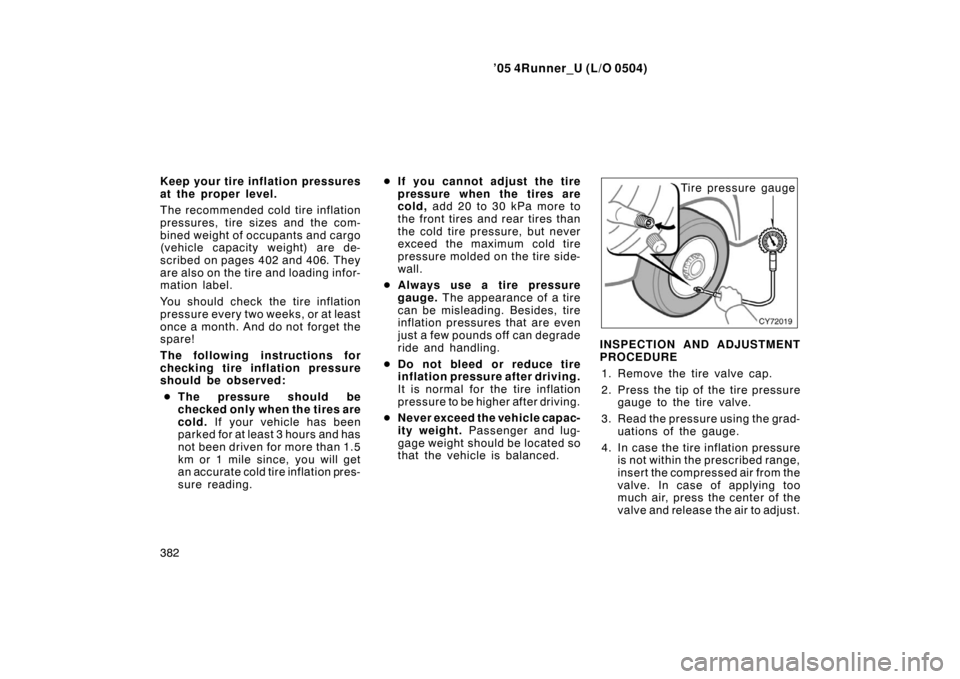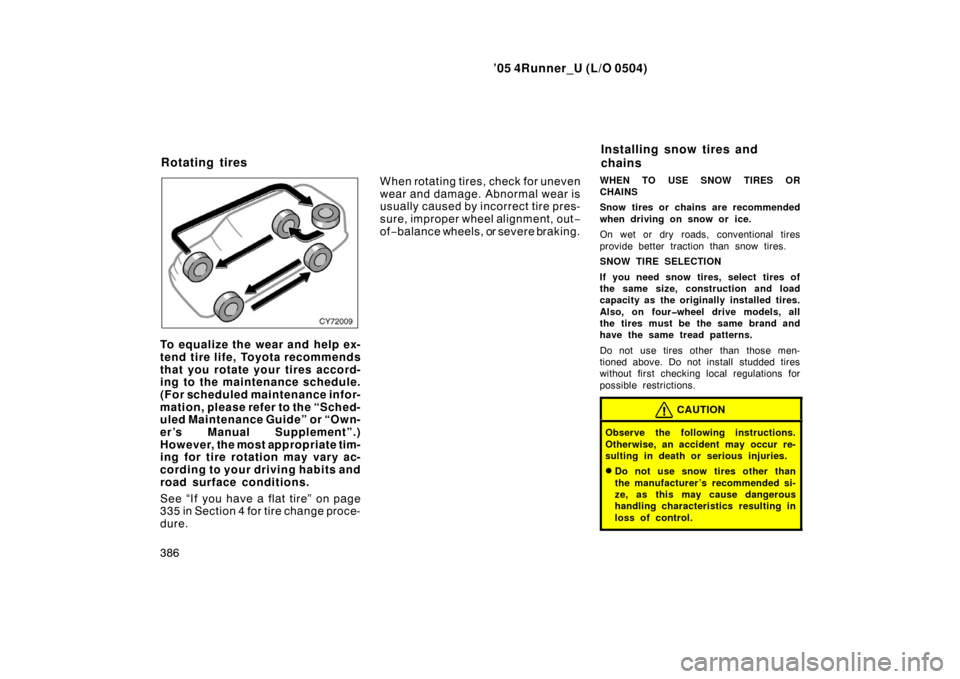Page 318 of 426

’05 4Runner_U (L/O 0504)
308
Cargo
capacityWeight of
t he rem ov ed
third seat
SEATING CONFIGURATION
VARIATION
In case of removing the rear seats,
it is possible to load as much cargo
as the weight of the removed seats.
(Cargo capacity) = (Total load capac-
ity) − (Total weight of occupants) +
(Weight of the removed rear seats)
Rear seats weights:
Each seat 11 kg (24 lb.) Determine what kind of tires your
vehicle is originally equipped with.
1. Summer tires
Summer tires are high −speed capabil-
ity tires best suited to highway driving
under dry conditions.
Since summer tires do not have the
same traction performance as snow
tires, summer tires are inadequate for
driving on snow −covered or icy roads.
For driving on snow −covered or icy
roads, we recommend using snow
tires. If installing snow tires, be sure
to replace all four tires.
2. All season tires
All season tires are designed to pro-
vide better traction in snow and to be
adequate for driving in most winter
conditions, as well as for use all year
round. All season tires, however, do not have
adequate traction performance
compared with snow tires in heavy or
loose snow. Also, all season tires fall
short in acceleration and handling
performance compared with summer
tires in highway driving.
The details about how to distinguish
summer tires from all season tires are
described on page 296.
CAUTION
�
Do not mix summer and all sea-
son tires on your vehicle as
this can cause dangerous han-
dling characteristics, resulting
in loss of control.
� Do not use tire other than the
manufacturer’s designated
tires, and never mix tires or
wheels of the sizes different
from the originals.
Types of tires
Page 392 of 426

’05 4Runner_U (L/O 0504)
382 Keep your tire inflation pressures
at the proper level.
The recommended cold tire inflation
pressures, tire sizes and the com-
bined weight of occupants and cargo
(vehicle capacity weight) are de-
scribed on pages 402 and 406. They
are also on the tire and loading infor-
mation label.
You should check the tire inflation
pressure every two weeks, or at least
once a month. And do not forget the
spare!
The following instructions for
checking tire inflation pressure
should be observed:
� The pressure s hould be
checked only when the tires are
cold. If your vehicle has been
parked for at least 3 hours and has
not been driven for more than 1.5
km or 1 mile since, you will get
an accurate cold tire inflation pres-
sure reading. �
If you cannot adjust the tire
pressure when the tires are
cold, add 20 to 30 kPa more to
the front tires and rear tires than
the cold tire pr essure, but never
exceed the maximum cold tire
pressure molded on the tire side-
wall.
� Always use a tire pressure
gauge. The appearance of a tire
can be misleading. Besides, tire
inflation pressures that are even
just a few pounds off can degrade
ride and handling.
� Do not bleed or reduce tire
inflation pressure after driving.
It is normal for the tire inflation
pressure to be higher after driving.
� Never exceed the vehicle capac-
ity weight. Passenger and lug-
gage weight should be located so
that the vehicle is balanced.
Tire pressure gauge
INSPECTION AND ADJUSTMENT
PROCEDURE 1. Remove the tire valve cap.
2. Press the tip of the tire pressure gauge to the tire valve.
3. Read the pressure using the grad- uations of the gauge.
4. In case the tire inflation pressure
is not within the prescribed range,
insert the compressed air from the
valve. In case of applying too
much air, press the center of the
valve and release the air to adjust.
Page 396 of 426

’05 4Runner_U (L/O 0504)
386
To equalize the wear and help ex-
tend tire life, Toyota recommends
that you rotate your tires accord-
ing to the maintenance schedule.
(For scheduled maintenance infor-
mation, please refer to the “Sched-
uled Maintenance Guide” or “Own-
er’s Manual Supplement”.)
However, the most appropriate tim-
ing for tire rotation may vary ac-
cording to your driving habits and
road surface conditions.
See “If you have a flat tire” on page
335 in Section 4 for tire change proce-
dure. When rotating tires, check for uneven
wear and damage. Abnormal wear is
usually caused by incorrect tire pres-
sure, improper wheel alignment, out
−
of −balance wheels, or severe braking.
WHEN TO USE SNOW TIRES OR
CHAINS
Snow tires or chains are recommended
when driving on snow or ice.
On wet or dry roads, conventional tires
provide better traction than snow tires.
SNOW TIRE SELECTION
If you need snow tires, select tires of
the same size, construction and load
capacity as the originally installed tires.
Also, on four�wheel drive models, all
the tires must be the same brand and
have the same tread patterns.
Do not use tires other than those men-
tioned above. Do not install studded tires
without first checking local regulations for
possible restrictions.
CAUTION
Observe the following instructions.
Otherwise, an accident may occur re-
sulting in death or serious injuries.
�Do not use snow tires other than
the manufacturer ’s recommended si-
ze, as this may cause dangerous
handling characteristics resulting in
loss of control.
Rotating tires Installing snow tires and
chains
Page 412 of 426

’05 4Runner_U (L/O 0504)
402
Towing capacity (trailer weight + cargo
weight), kg (lb.):
For weight carrying hitch 2268 (5000)
Also for weight distributing hitch
1GR −FE engine
Tw o −wheel drive models
3042 (6700)
Four −wheel drive models
2906 (6400)
2UZ− FE engine
Tw o −wheel drive models
3311 (7300)
Four −wheel drive models
3175 (7000)
Dimensions and weights
Overall width mm (in.)
2790 (109.8)
Overall height
∗
1mm (in.)
1575 (62.0)
Wheelbase mm (in.)
Front tread mm (in.) 1575 (62.0)
Rear tread mm (in.)
431 (950)
∗7
476 (1050)∗8
∗1: Unladen vehicle∗2: With two −wheel drive models∗
3: With four −wheel drive models∗
4: With roof rails∗5: With rear spoiler∗6: With rear height control air suspension∗7: With 5 occupants∗8: With 7 occupantsOverall length mm (in.)
Vehicle capacity weight (occupants + luggage)
kg (lb.)4800 (189.0)
1875 (73.8)
1820 (71.7)
∗
2or3,4
1800 (70.9)∗2, 3, 5
1755 (69.1)∗2, 3
1805 (71.1)∗2 or 3,4,6
1785 (70.3)∗2 or 3,5,6
1740 (68.5)∗2or3,6
91 (200)∗7
0(0)∗8Luggage compartment load capacity kg (lb.)